Dogwoods are popular shrubs or small trees for almost any location with a good water supply. We present the most beautiful Cornus species and varieties.

The Hornbush or dogwood (Cornus) is one of the wild, widespread shrubs in our latitudes, but numerous ornamental species have also found their way into our gardens. We give an overview of the most beautiful dogwood species and varieties.
contents
- Dogwood Varieties and Species: How Many Are There?
-
The most beautiful dogwood types and varieties at a glance
- American flower dogwood (Cornus nuttallii)
- Flower Dogwood (Cornus florida)
- Blood Red Dogwood (Cornus sanguinea)
- Yellow dogwood (Cornus sericea)
- Japanese cornel (Cornus officinalis)
- Japanese Flower Dogwood (Cornus kousa)
- Cornelian cherry (Cornus mas)
- Pagoda Dogwood (Cornus controversa)
- Swedish Dogwood (Cornus suecica)
- Carpet dogwood (Cornus canadensis)
- Alternate-leaved dogwood (Cornus alternifolia)
- White Dogwood (Cornus alba)
Dogwood Varieties and Species: How Many Are There?
The dogwood genus includes around 50 to 60 species, which are mainly distributed in the temperate zone of the northern hemisphere. The deciduous, hardy shrubs to small trees are generally undemanding in terms of location. They are also vigorous and tolerate pruning well, which is why some species are often used in flowering bird protection hedges. The flowers are small and umbellate, or surrounded by large, white or colored bracts, the bracts. The white, black, or red fruits are often edible, and many dogwood species display bright colors in fall and winter.

The most beautiful dogwood types and varieties at a glance
Dogwoods can be planted in a variety of ways in gardens, as ornaments or as wild edible fruit. Whether as a ground cover, shrub or small tree, there are different types and varieties of dogwood to choose from for almost every growth form.
American flower dogwood (Cornus nuttallii)
The American flower dogwood, or Nuttall's dogwood, is native to western North America. The tall, upright shrub is common there as undergrowth in coniferous forests. In our latitudes it reaches a growth height of 3 to 6 m, in its homeland even up to 15 m. It prefers fresh to moist, but well-drained and humus-rich soil with an acidic to neutral pH. The opposite, elliptical leaves show a bright yellow to orange-red autumn color in autumn. The very small flowers are surrounded by four to eight - usually six - white to pink tinged bracts, so that the inflorescence appears 10 cm and larger. Red to orange, about 1 cm long fruits ripen from October. The vigorous and frost-hardy variety 'Eddie's White Wonder' can reach a height of 4 to 6 m and a spread of up to 5 m. Four to five creamy white to greenish white bracts surround the numerous flowers that appear in May.

Flower Dogwood (Cornus florida)
The flowering dogwood comes from the forests of North America and forms spreading, but slow-growing large shrubs to small trees of 4 to 6 m in height and width. The large, ovate, pointed leaves are opposite on green-purple shoots. The magnificent autumn color of the flower dogwood shines in scarlet to violet. Between May and June, the white-framed, up to 9 cm large flowers of the dogwood appear in large numbers. Cornus florida 'Rubra' forms extraordinary pink bracts in May. The scarlet, egg-shaped fruits appear between late summer and fall. The ideal location for the flower dogwood is on fresh, slightly acidic to neutral, humus-rich and well-drained soil in sun to partial shade.
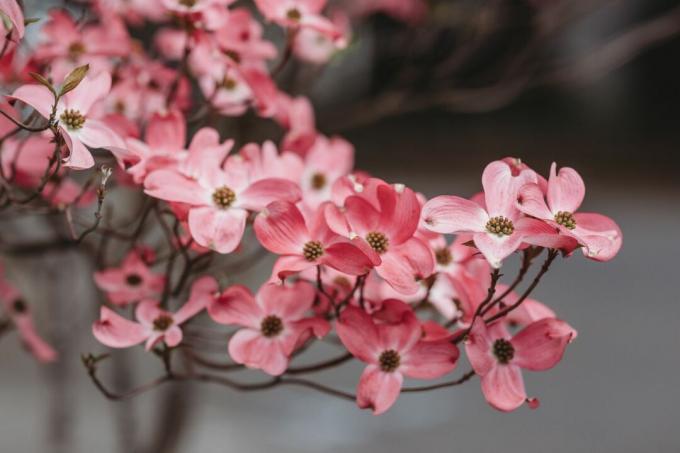
Blood Red Dogwood (Cornus sanguinea)
The blood-red or red dogwood is a native and widespread wild and bird food tree, which is why it is also known as the common dogwood. The completely undemanding, vigorous and robust dogwood species prefers to thrive on forest edges on calcareous to weakly acidic, moist to dry soil in sun to partial shade. The tall shrubs reach an average height of 4 m and spread wide when old. The leaves, which are bright burgundy to orange in autumn, are opposite on the blood-red shoots. The dogwood variety 'Winter Beauty' inspires with orange-yellow shoots. Between May and June clusters of white, slightly fragrant flowers appear in cymes. These form black, spherical drupes, which are slightly poisonous when raw, but are used as jam, juice or in herbal medicine.

Yellow dogwood (Cornus sericea)
The Yellow Dogwood is also known as Yellowwood Dogwood or Silky Dogwood. The light green to bright yellow shoots, which are particularly eye-catching in winter after the leaves have fallen, give the plant its name. The shrubs with many shoots, which originate from North America, prefer fresh to moist locations on almost all soils with an acidic to alkaline pH value. The yellowwood dogwood can grow 1.5 to 3 m in height and just as wide with age. The oppositely arranged leaves are ovate to lanceolate in shape and light green in colour. In May, the yellowish-white flowers appear in large panicles and attract numerous insects. White, round fruits with a diameter of 7 to 9 mm remain on the bush well into winter. The hardy yellow dogwood can spread widely and even survive floods. the Cornus-Varieties 'Flaviramea' and 'Kelseyi' are the best known of this species. While 'Flaviramea' attracts attention with its bright yellow shoots, 'Kelseyi' shows itself as Dwarf dogwood with a low growth height of up to 0.75 m, which makes it an optimal Low hedge plant power.
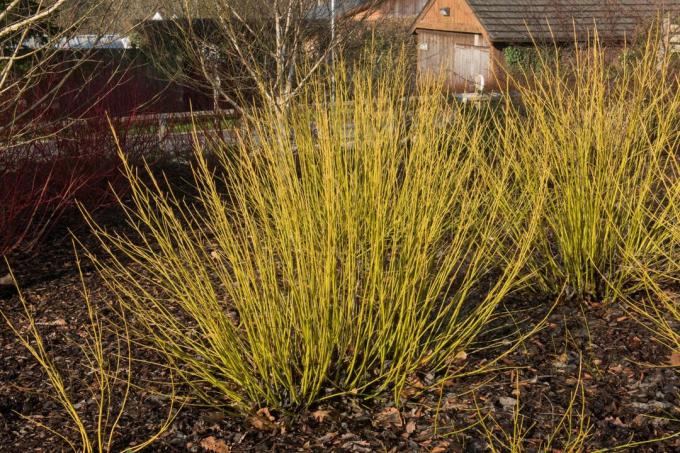
Japanese cornel (Cornus officinalis)
The Japanese cornel can grow into a stately tree of 4 to 7 m in height. The fruit tree, which is native to China, Japan and Korea, quickly grows in size, especially when it is young. The decorative small tree is particularly suitable as a solitary tree on fresh to moist, well-drained soil in sunny to partially shaded locations. Between March and April, the Japanese cornel attracts numerous bees and other pollinators to the light yellow flowers that are still bare branches. The red stone fruits ripen from August and are ornamental, food for birds and small mammals and suitable for processing as healthy wild fruit for jams or compotes. The fruits fall in contrast to Cornus mas do not always detach from the tree, but can get stuck over the winter. In autumn, this Asian dogwood shows a reddish-brown fall color on the rather narrow, grey-brown branches.

Japanese Flower Dogwood (Cornus kousa)
The Japanese flower dogwood, also known as the fruit dogwood, is native to the mountain forests of Japan and Korea. The Chinese Dogwood (Cornus kousa var. chinensis) ages more slowly, which is why numerous varieties of this variant can be assigned to the species. The shrubs, which are up to 6 m high and 4.5 m wide, can now be found in many gardens thanks to their shapely growth. The elliptically pointed leaves are matt blue-green on the underside and turn yellow to scarlet in autumn. Green-yellow flowers appear from the end of May to June, surrounded by four green-white to pink-red bracts. However, its use as a tasty wild fruit is hardly known in this country. The raspberry-like, long-stemmed fruits of the Japanese dogwood are also known as mountain lychee and are a popular fruit tree in East Asian countries. The fruits are eaten raw or processed, enjoying only the creamy, yellow-orange flesh and not the tough pink skin.
- 'Cappuccino': Large and compact growing variety from 2010 with 4-6 m in height and 2-3 m in width. In addition to the reddish-brown foliage, the creamy-white to pink inflorescences are also extremely attractive.
- 'Chinese Girl': Tall shrub with a loosely upright crown and thin, light brown shoots. The bright red autumn colour, the white-greenish flowers and the aromatic, sweet fruits make 'China Girl' a popular fruit dogwood variety.
- 'John Slocock': Up to 3.5 m tall, slow-growing, compact large shrub with white flower bracts, which over time stand out with dark pink speckles and tips.

- 'Satomi': High-growing, layer-forming variety up to 6 m tall and pink colored bracts around the yellow-green flowers. The raw edible fruits are characterized by their sweet, creamy and fruity taste.
- 'Teutonia': Fruit dogwood up to 3 m tall, pink tinged bracts and the largest fruits to date with a diameter of around 3 cm.
- 'Venus': Large shrub to small tree with horizontal branches between 3 - 4 m final height. The 'Venus' dogwood forms remarkably large, pure white bracts, so that the inflorescences have a diameter of up to 13 cm.
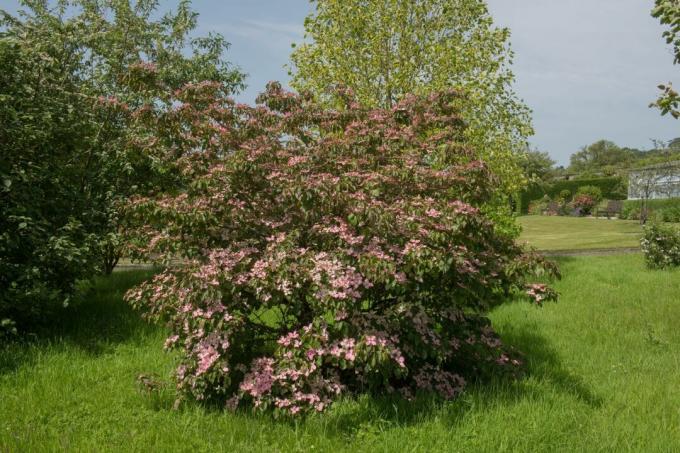
Cornelian cherry (Cornus mas)
the cornel is a wild fruit tree that is now widespread again. It grows as a large shrub to a small tree of 6 - 8 m. In contrast to the Japanese cornel forms Cornus mas significantly larger fruits, which always fall off the bush when fully ripe. The sun-yellow flowers in spherical cymes appear between February and April on the shoots that are still bare in winter. From August to September, the 2 to 3 cm large, mostly deep red, sometimes yellow stone fruits ripen. The raw, edible but sour pulp shines when processed into jam or mush with an extraordinary, fruity taste. This dogwood species was selected with a focus on yield, fruit size and taste. Popular varieties include 'Jolico', 'Kasanlak' and 'Yellow'.
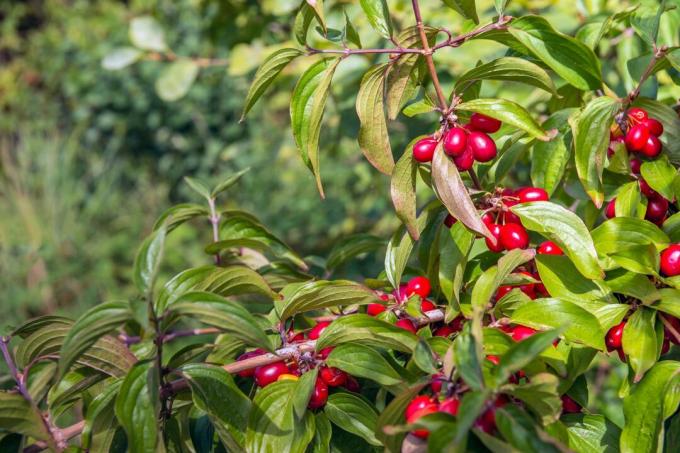
Pagoda Dogwood (Cornus controversa)
Also known as tiered dogwood, the pagoda dogwood stands out due to its horizontally arranged tiered side shoots. the Cornus-Art is originally from Korea and Japan. The tall shrub or small tree reaches a height of 5 to 8 m and can be just as wide. The alternate leaves are elliptical and short-pointed, but vary greatly in shape and size. The up to 15 cm large panicles appear in June and each contain hundreds of small white flowers. After pollination, numerous, black-blue, thick and round fruits develop. The pagoda dogwood prefers moist to moist soil with good drainage and an acidic to neutral pH. The variegated dogwood 'Variegata' and 'Pagoda' are particularly well known for their sprawling growth.
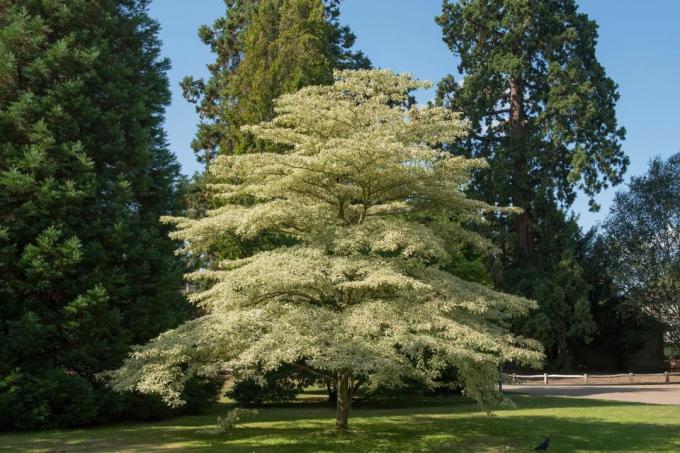
Swedish Dogwood (Cornus suecica)
The Swedish dogwood occurs in the sub-polar regions and forms delicate carpets on acidic, humus-rich forest floors in the shade to semi-shade. The location-sensitive species, about 10 cm high, has opposite, entire, oval-round leaves. It forms delicate white bracts with a blue-grey center between July and August. From September, edible but bland-tasting red fruits appear, the seeds of which are spread by animals.
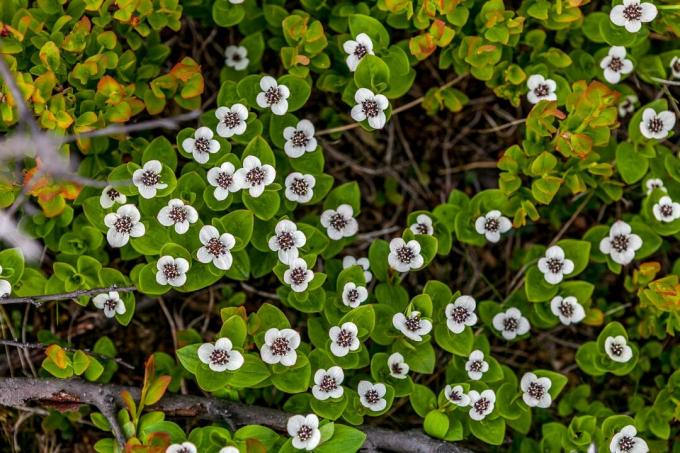
Carpet dogwood (Cornus canadensis)
Also known as the Canadian dogwood, the carpet dogwood is found throughout North America, Greenland and Japan. The creeping, runner-forming perennials reach a height of 10 - 20 cm and are suitable as ground cover dogwood for moist, slightly acidic to neutral forest soils in partial shade. In mild winters, the carpet dogwood is evergreen with a slight orange-reddish tinge to the rather small, ovate, pointed leaves. The flowers surrounded by white bracts appear in June. The knobbly fruits are bright red in color and resemble the Swedish dogwood.

Alternate-leaved dogwood (Cornus alternifolia)
The changeleaf dogwood originally comes from North America, where it occurs in the undergrowth, along the water's edge and in swampy areas. The optimal location is sunny to semi-shady on acidic to neutral, humus-rich, fresh to moist soil with good drainage. The upright shrub grows to 3-6 m in height and 2-5 m in spread. The growth habit is reminiscent of the pagoda dogwood, as the expansive side branches protrude in tiers. Unlike many others Cornusspecies, the broadly ovate leaves are alternate on the purplish-brown to gray shoots. The flowers are clustered in broad panicles and bloom between May and June. In autumn, blue-black frosted stone fruits develop on red stalks, which are eaten by birds.
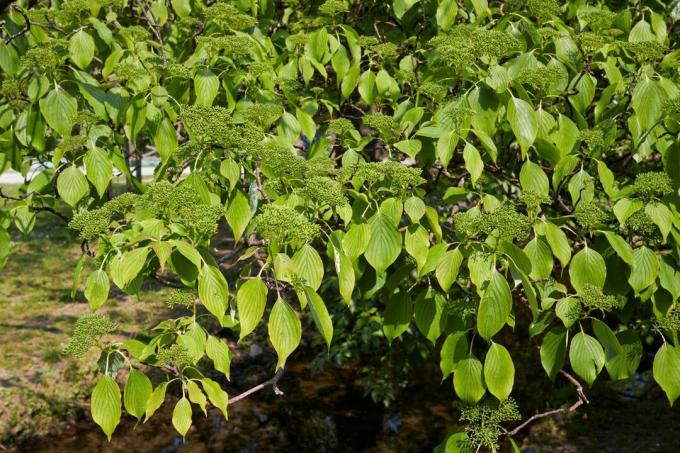
White Dogwood (Cornus alba)
The white or Tatar dogwood originally comes from a wide area from Eastern Europe to Siberia to North Korea. The large shrub reaches a height of 3 to 4 m and is usually wider than it is tall when it is old. The bark of young shoots appears blood-red and darkens to a black-brown color with age. The green-bluish, egg-shaped leaves turn yellow to orange-red in autumn. Between May and June, yellowish-white flowers open in cymes, which, after pollination, ripen into pea-sized, white to bluish fruits. The white dogwood has no special demands on the soil and is lime-tolerant. However, it prefers moist locations, on which it sometimes spreads strongly.
- 'Elegantissima': White Variegated Dogwood. The variety was formerly listed under 'Argenteomarginata'. The shrubs are up to 3 m tall and wide, the foliage is irregularly variegated cream-white at the leaf edge, yellowish-white in young leaves.
- 'Sibirica': The Siberian dogwood attracts attention with its coral-red shoots, which bring a bright red to the garden even in winter. Cornus alba 'Sibirica' reaches a growth height and width of 3 m.

- ‘Sibirica Variegata’: The variety grows similar to 'Sibirica' and offers bright red shoots. Cornus alba However, 'Sibirica Variegata' also stands out due to the white variegated and reddish to pink tinged leaves, which gave it the nickname of the variegated dogwood.
- ‘Spaethii’: Yellow-colored dogwood with lemon-yellow framed, variegated leaves and brown-orange shoots. The plants grow to a height of about 3 m and often become very wide when they are old.

the strawberry tree (arbutus) forms round, red and edible fruits similar to the fruit dogwood. You can find out from us how you can cultivate this rarity in your own garden.



